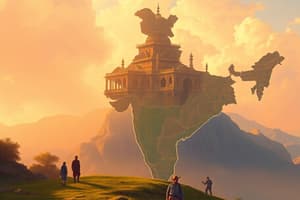Podcast
Questions and Answers
What are the latitudes that bound India?
What are the latitudes that bound India?
- 8°4’N and 37°6’N (correct)
- 15,200km and 7516.6km
- 22°N and 82°30’E
- 23°30’N and 68°7’E
What is the total area of India?
What is the total area of India?
- 2.4% of the total geographical area of the world
- 7516.6km
- 7th largest country in the world
- 3.28 million square km (correct)
What divides India into almost two equal parts?
What divides India into almost two equal parts?
- Lakshadweep Islands
- Arabian Sea
- Tropic of Cancer (correct)
- Andaman and Nicobar Islands
Why is there a time lag of 2 hours from Gujarat to Arunachal Pradesh?
Why is there a time lag of 2 hours from Gujarat to Arunachal Pradesh?
Which mountains are located in the northwest, north, and northeast of India?
Which mountains are located in the northwest, north, and northeast of India?
What influences the duration of day and night as one moves from south to north in India?
What influences the duration of day and night as one moves from south to north in India?
What is the significance of India's central location at the head of the Indian Ocean?
What is the significance of India's central location at the head of the Indian Ocean?
How has the long coastline been beneficial to India in terms of international trade and relations?
How has the long coastline been beneficial to India in terms of international trade and relations?
Why are India's relationships through land routes considered older than its maritime contacts?
Why are India's relationships through land routes considered older than its maritime contacts?
How does India's physical geography contribute to its strategic position in South Asia?
How does India's physical geography contribute to its strategic position in South Asia?
What role does the Peninsular Plateau play in India's varied land forms?
What role does the Peninsular Plateau play in India's varied land forms?
How does the Deccan Plateau contribute to India's connections with other regions?
How does the Deccan Plateau contribute to India's connections with other regions?
What is significant about India's contacts with the world through land routes?
What is significant about India's contacts with the world through land routes?
What is unique about India's position in South Asia?
What is unique about India's position in South Asia?
How does the trans-Indian Ocean route contribute to India's strategic positioning?
How does the trans-Indian Ocean route contribute to India's strategic positioning?
What is remarkable about India's influence on other regions?
What is remarkable about India's influence on other regions?
Flashcards
India's Latitudinal Extent
India's Latitudinal Extent
8°4’N and 37°6’N
Total Area of India
Total Area of India
3.28 million square km
Divides India in Half
Divides India in Half
Tropic of Cancer
Time Lag Cause: Gujarat to Arunachal Pradesh
Time Lag Cause: Gujarat to Arunachal Pradesh
Signup and view all the flashcards
Mountains in Northwest, North, Northeast India
Mountains in Northwest, North, Northeast India
Signup and view all the flashcards
Influences Day/Night Duration
Influences Day/Night Duration
Signup and view all the flashcards
Central Location Significance
Central Location Significance
Signup and view all the flashcards
Long Coastline Benefits
Long Coastline Benefits
Signup and view all the flashcards
Land Routes Older Than Maritime
Land Routes Older Than Maritime
Signup and view all the flashcards
India's Strategic Position in South Asia
India's Strategic Position in South Asia
Signup and view all the flashcards
Role of the Peninsular Plateau
Role of the Peninsular Plateau
Signup and view all the flashcards
Deccan Plateau's Contribution
Deccan Plateau's Contribution
Signup and view all the flashcards
Significance of India's Land Routes
Significance of India's Land Routes
Signup and view all the flashcards
India's Unique Position in South Asia
India's Unique Position in South Asia
Signup and view all the flashcards
Trans-Indian Ocean Route
Trans-Indian Ocean Route
Signup and view all the flashcards
India's Worldwide Influence
India's Worldwide Influence
Signup and view all the flashcards
Study Notes
India's Geography
- India is bounded by latitudes 8°4’N and 37°6’N.
- The total area of India is approximately 3.28 million square kilometers.
India's Division
- The Tropic of Cancer divides India into almost two equal parts.
Time Zone
- There is a time lag of 2 hours from Gujarat to Arunachal Pradesh due to the longitudinal extent of India.
Mountain Ranges
- The Himalayan mountain range is located in the northwest, north, and northeast of India.
Day and Night Duration
- The duration of day and night varies as one moves from south to north in India due to the latitudinal extent of the country.
Central Location
- India's central location at the head of the Indian Ocean has significance in influencing international trade and relations.
Coastline Benefits
- India's long coastline has been beneficial for international trade and relations.
Land Routes
- India's relationships through land routes are considered older than its maritime contacts.
- India's physical geography contributes to its strategic position in South Asia.
Peninsular Plateau
- The Peninsular Plateau plays a significant role in India's varied land forms.
Deccan Plateau
- The Deccan Plateau contributes to India's connections with other regions.
Land Route Significance
- India's contacts with the world through land routes are significant.
Unique Position
- India's position in South Asia is unique.
Trans-Indian Ocean Route
- The trans-Indian Ocean route contributes to India's strategic positioning.
Influence on Regions
- India's influence on other regions is remarkable.
Studying That Suits You
Use AI to generate personalized quizzes and flashcards to suit your learning preferences.




